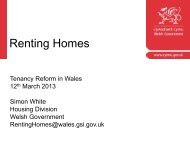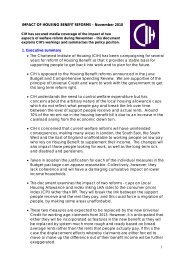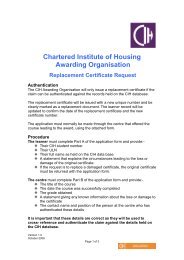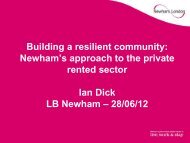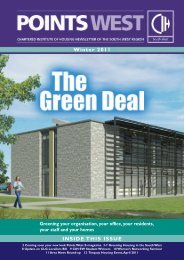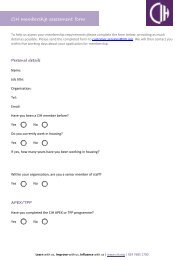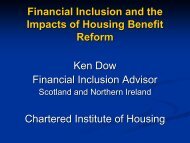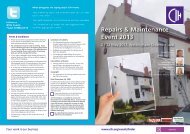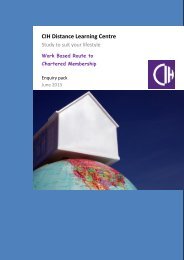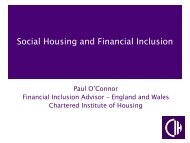View publication - Chartered Institute of Housing
View publication - Chartered Institute of Housing
View publication - Chartered Institute of Housing
You also want an ePaper? Increase the reach of your titles
YUMPU automatically turns print PDFs into web optimized ePapers that Google loves.
PART ONE: LEARNING TODAY<br />
Meeting the skills challenge <strong>of</strong> the residential property<br />
management sector<br />
By Bob Keats, Examiner for the IRPM and Jeff Platt, Chief Executive <strong>of</strong> the IRPM<br />
Summary<br />
Over the past ten years residential property managers have seen the<br />
pr<strong>of</strong>essionalisation <strong>of</strong> their activity. With this has come rising management<br />
standards for clients and customers alike. Landlord and tenant law is different<br />
for long leaseholders with variable service charges so the use <strong>of</strong> knowledge<br />
and the ability to apply that knowledge in a competitive environment is<br />
essential. The IRPM provides the credentials for experienced and well trained<br />
property managers. The wider housing industry can learn from the<br />
experiences <strong>of</strong> the residential property management sector in terms <strong>of</strong><br />
customer engagement and service quality.<br />
The IRPM at Ten<br />
The <strong>Institute</strong> <strong>of</strong> Residential Property Management (IRPM) is ten years old. It was<br />
incorporated at the end <strong>of</strong> 2002 and now the new pr<strong>of</strong>essional association has grown<br />
to almost 3,000 members. It holds a niche position in the existing framework <strong>of</strong><br />
pr<strong>of</strong>essional associations which includes RICS and CIH and it sits between the two:<br />
RICS focuses on property; and in addition to bricks and mortar CIH embraces wider<br />
community dimensions. The IRPM links both <strong>of</strong> these for the management <strong>of</strong><br />
leasehold blocks.<br />
In those ten years the economy has swung from boom to bust and those investing at<br />
the height <strong>of</strong> the market have struggled, many others have done very well. There have<br />
been leaseholders right back to the middle ages, but leasehold flats are a more recent,<br />
twentieth century phenomenon. High rise and high density living in our urban centres<br />
has now created almost two million leasehold flats in England and Wales and the<br />
common parts <strong>of</strong> these buildings need managing. Some blocks are managed collectively<br />
by groups <strong>of</strong> leaseholders, some managed by individual landlords and some by<br />
managing agents. The picture more recently has been complicated by mixed tenure<br />
developments encouraged by S106 <strong>of</strong> the Town and Country Planning Act 1990, so<br />
now there are leaseholders, investors, social housing tenants and private sector tenants<br />
living side by side.<br />
54



